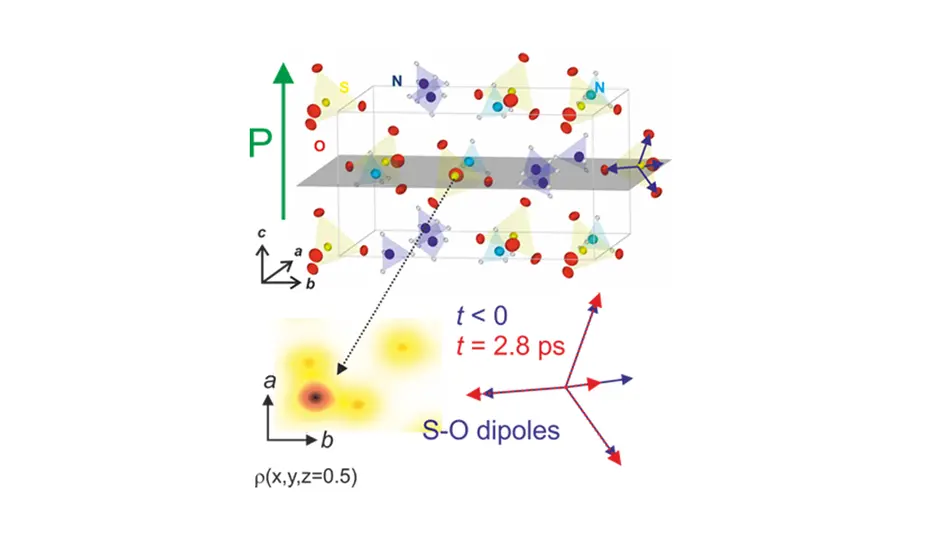Electric polarization in the macroscopic world and electrons moving at atomic scales
New route for understanding and tailoring the properties of ferroelectric materials
Femtosecond x-ray experiments in combination with a new theoretical approach establish a direct connection between electric properties in the macroscopic world and electron motions on the time and length scale of atoms. The results open a new route for understanding and tailoring the properties of ferroelectric materials.
Phenomena in the macroscopic world are described by classical physics while processes at atomic length and time scales are governed by the laws of quantum mechanics. The connection between microscopic and macroscopic physical quantities is far from being trivial and partly unexplained.
The electric polarization is a macroscopic quantity which describes the dipole moment of matter. The polarization originates from the peculiar electron distribution at the atomic scale in polar and ionic materials, among them the most interesting class of ferroelectrics. Their spontaneous electric polarization is widely applied in electronic sensors, memories, and switching devices. The link between polarizations, in particular time dependent ones, and microscopic electron densities is important for understanding and tailoring the properties of ferroelectrics.
Based on a new experimental and theoretical approach, scientists from the Max-Born-Institute have now established a direct quantitative connection between macroscopic electric polarizations and time-dependent microscopic electron densities. As they report in Physical Review B, atomic motions in ferroelectrics are launched by optical excitation and modulate the electron distribution on a femtosecond time scale (1 fs = 10-15 seconds). The resulting dynamics of electron density are mapped by time-resolved x-ray powder diffraction. Such data allow for the generation of temporally and spatially resolved electron density maps from which the momentary macroscopic polarization is derived with the help of a new theoretical concept. The potential of the method is demonstrated with two prototype ferroelectric materials.
The theoretical work extends the existing quantum phase approach for calculating stationary macroscopic polarizations towards ultrafast nonequilibrium dynamics of electron charge and polarization. The theoretical key steps consist in deriving a microscopic current density from time-dependent electron density maps while minimizing the electron kinetic energy, and calculating the macroscopic polarization from the current density. This method is applied to the prototype ferroelectric material ammonium sulfate [(NH4)2SO4, Fig. 1] with the time dependent electron and current densities shown in the movie attached. As a second prototype system, potassium dihydrogen phosphate [KH2PO4] was investigated. The analysis provides macroscopic polarizations and their absolute values as governed by microscopic vibrations.
The results establish ultrafast x-ray diffraction as a unique tool for grasping macroscopic electric properties of complex materials. The broad relevance of this new insight is underlined by the selection of the article as an "Editor's Suggestion".
Figure 1: Top: Crystal lattice of ferroelectric ammonium sulfate [(NH4)2SO4] with tilted ammonium (NH4+ tetrahedra (nitrogen: blue, hydrogen: white) and sulfate (SO42-) tetrahedra (sulfur: yellow, oxygen: red). The green arrow shows the direction of the macroscopic polarization P. Blue arrows: local dipoles between sulphur and oxygen atoms. The electron density maps shown in the bottom left panel and the movie are taken in the plane highlighted in grey. Bottom left: Stationary electron density with a high value on the sulfur (red) and smaller values on the oxygen atoms (yellow). Bottom right: Change of local dipoles at a delay time of 2.8 picoseconds (ps) after excitation of the ammonium sulfate sample. An anisotropic shift of charge reduces the dipole pointing to the right and increases the other 3 dipoles.
Original publication:
Christoph Hauf, Michael Woerner, and Thomas Elsaesser
Macroscopic electric polarization and microscopic electron dynamics: Quantitative insight from femtosecond x-ray diffraction
Phys.Rev. B 98, 054306 (2018, Editor's Suggestion).
Contact:
Max Born Institute for Nonlinear Optics and Short Pulse Spectroscopy
Dr. Christoph Hauf
Tel.: 030 6392-1473
hauf(at)mbi-berlin.de
Dr. Michael Wörner
Tel.: 030 6392-1470
woerner(at)mbi-berlin.de
Prof. Dr. Thomas Elsaesser
Tel.: 030 6392-1400
elsasser(at)mbi-berlin.de
